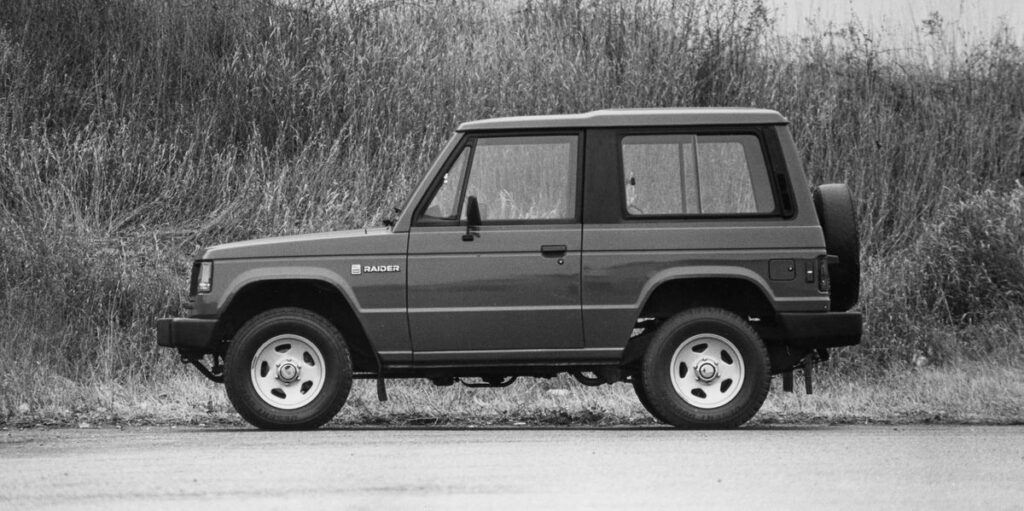1987 Dodge Raider: Chrysler's Japanese Bronco

From the June 1987 issue of Car and Driver.
Chrysler has been dining on delicacies from Mitsubishi so long, it hardly even bothers to cook anymore. For a decade and a half, the corporation’s appetite for small cars and trucks has been sated largely by its Japanese trading partner. It was only natural, then, for Chrysler to scan the Mitsubishi menu when it got hungry for a new four-wheel-drive utility vehicle. When the Chrysler guys got down to “Montero,” they called Mitsubishi and said, “Guess who’s coming to dinner?”
Chrysler seized on the Montero because the corporation’s lineup looked like a gap-toothed grin. Missing from the Dodge brigade was anything like the Jeep Wrangler, the Suzuki Samurai, or the Ford Bronco II. Such vehicles represent the small, boxy end of the off-roader market—rigs that are less bulky than even the mid-size Chevrolet S-10 Blazer and the Jeep Cherokee. Mitsubishi’s Montero fits this group to a T.
Those of you who like four-wheel encounters of the dirt kind will recall that Mitsubishi introduced the Montero to the U.S. market in 1983. The new Dodge Raider is the Montero’s twin: it’s a Japanese execution of the Bronco II’s basic theme, and it’s virtually the same size as the Ford, give or take an inch or two in the critical dimensions.
The Raider’s layout follows the class blueprint closely. Its construction is body-on-frame. Its suspension consists of control arms and torsion ban up front and a rigid axle and leaf springs in the rear. The well-known Mitsubishi 2.6-liter four-cylinder (complete with balance shafts) sends its 109 horsepower through either a five-speed manual or a four-speed automatic transmission. Part-time 4wd, a two-speed transfer case, and automatically locking front hubs are standard equipment.
So far, the Raider could be Anytruck, 4wd division. The Japanese flavor comes from its long list of standard features and the way it goes about its job. There are some differences, however, between the Dodge and Mitsubishi ways of doing business off-road.
The Montero comes into this world in either base or Sport guise, but the Raider is a synthesis of the two. The Dodge gets its clothes from the base Montero. All of its trim—including the grille, moldings, mirrors, and bumpers—is black. The low-key look is fine by us, but California four-by aficionados will probably lapse into chrome withdrawal. From the Montero Sport the Raider gets full carpeting, cloth seats, the automatically locking front hubs, and, in the center of the dash, an auxiliary gauge panel, which includes an inclinometer. Similar to an aircraft’s artificial-horizon indicator, the inclinometer measures the angle of grades and warns of impending tip-over; its readings are trustworthy, however, only when the Raider is stationary. A tach, a tilt wheel, a tailgate-mounted spare tire, front and rear skid plates, spoker wheels, and tinted glass are also standard.
Despite today’s stronger yen, the Raider is a good value. You get a lot of stuff here for not much money. Our red test Raider was decked out to the gunwales but didn’t cost a second mortgage. Even with A/C, a rear bench seat, an off-road package (which includes a neat, independently suspended driver’s seat), and more, the tab came to only $12,212.
That amount of cash delivers a relatively civilized four-by-four, but nothing you’d ever confuse with a passenger car. Various sedans from Honda, Toyota, Audi, and other makers integrate 4wd so well that you might never guess they have four paws available for locomotion. The Raider couldn’t fool you on a bet. From its slab sides to its tall-in-the-saddle driving position, it’s pure truck.
In terms of performance, the Raider has enough to get by, but none to spare. With 3370 pounds of road-hugging weight to haul around, the big four has its hands full getting to 60 mph in less than sixteen seconds. You can keep up with traffic without much strain and cruise comfortably at 70 to 75 mph, but thrills are not included.
Nor does the Raider win any gold stars for ride and handling. For vehicles in this class, it’s strictly mid-pack. The six-foot-tall body tips precariously in hard cornering, easily pegging the inclinometer. Partly because of its short wheelbase (92.5 inches), the Raider hobbyhorses over most bumps. At least the suspended driver’s seat helps soften the jolts.
Dial-a-physique: The suspended driver’s seat can accommodate pilots from mini to massive.
Dick Kelley|Car and Driver
Mitsubishi deserves praise for including this ingenious perch. Similar to the seats in long-haul semis, it’s suspended from below, with coil springs and a hydraulic damper to absorb vertical loads. You can set the springs to handle physiques ranging from 125 pounds to more than 225, or you can lock the suspension system down if you so desire.
We devoted most of our time with the Raider to evaluating its on-road behavior, because the civilized world is where most Raiders will roll up most of their miles. But what of the mudslinger living in its soul? We also spent some time exploring unpaved territory, and here the Raider is more in its element. Its Jeep-like features—8.3 inches of ground clearance, fat mud-and-snow tires, all-wheel drive, and skid plates—give you a sense of invincibility that makes you go looking for trouble over the next hill. Like most of its competition, the Raider should be nearly unstoppable if driven intelligently.
Looked at this way, the Raider basks in a much more flattering light. For a rough-and-tumble off-road rig, it’s practically urbane. Its interior is almost luxurious for a vehicle in the mountain-goat division, its gearbox snicks with Japanese precision, and its stately coachwork can get by, more or less, in polite society.
Ultimately, the goodness of a vehicle like the Dodge Raider is in the eye of the beholder. If, when you gaze into its paint, you see yourself in an Eddie Bauer down jacket and hiking boots, you may be on to something. On the other hand, if your reflection is wearing a business suit, look elsewhere.
Arrow pointing downArrow pointing down
Specifications
Specifications
1987 Dodge Raider
Vehicle Type: front-engine, rear/4-wheel-drive, 4-passenger, 3-door wagon
PRICE
Base/As Tested: $10,542/$12,212
Options: air conditioning, $719; rear seat, $358; off-road package, $251; AM/FM-stereo radio, $170; rear wiper/washer, $108; rear defroster, $34; spare-tire cover, $30
ENGINE
SOHC inline-4, iron block and aluminum head, direct fuel injection
Displacement: 156 in3, 2555 cm3
Power: 109 hp @ 5000 rpm
Torque: 142 lb-ft @ 3000 rpm
TRANSMISSION
5-speed manual
CHASSIS
Suspension, F/R: control arms/rigid axle
Brakes, F/R: 10.0-in vented disc/10.0-in drum
Tires: Bridgestone Desert Dueler
P225/75R-15 M+S
DIMENSIONS
Wheelbase: 92.5 in
Length: 157.3 in
Width: 66.1 in
Height: 72.8 in
Passenger Volume, F/R: 46/35 ft3
Cargo Volume: 14 ft3
Curb Weight: 3370 lb
C/D TEST RESULTS
30 mph: 4.1 sec
60 mph: 15.3 sec
1/4-Mile: 19.8 sec @ 66 mph
80 mph: 38.1 sec
Top Gear, 30–50 mph: 12.9 sec
Top Gear, 50–70 mph: 17.7 sec
Top Speed: 86 mph
Braking, 70–0 mph: 204 ft
Roadholding, 300-ft Skidpad: 0.68 g
C/D FUEL ECONOMY
Observed: 14 mpg
EPA FUEL ECONOMY
City/Highway: 17/20 mpg
C/D TESTING EXPLAINED

Director, Buyer’s Guide
Rich Ceppos has evaluated automobiles and automotive technology during a career that has encompassed 10 years at General Motors, two stints at Car and Driver totaling 19 years, and thousands of miles logged in racing cars. He was in music school when he realized what he really wanted to do in life and, somehow, it’s worked out. In between his two C/D postings he served as executive editor of Automobile Magazine; was an executive vice president at Campbell Marketing & Communications; worked in GM’s product-development area; and became publisher of Autoweek. He has raced continuously since college, held SCCA and IMSA pro racing licenses, and has competed in the 24 Hours of Daytona. He currently ministers to a 1999 Miata and a 1965 Corvette convertible and appreciates that none of his younger colleagues have yet uttered “Okay, Boomer” when he tells one of his stories about the crazy old days at C/D.



